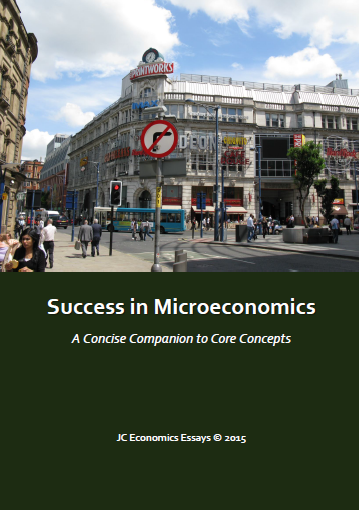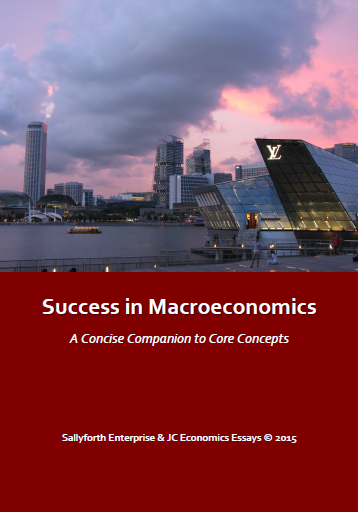Discuss the extent to which globalisation
has helped Singapore
achieve its macroeconomic objectives. [25]
This
paper discusses the extent to which globalisation has helped Singapore
achieve its macroeconomic objectives. Globalisation refers to the integration
of economies through greater flows of trade, capital, labour, and technology
across international borders. Singapore’s
four main macroeconomic objectives are high and stable economic growth, a low
inflation rate, low unemployment, and a favourable balance of payments (BOP).
To a large extent, globalisation has helped Singapore achieve its macroeconomic
objectives; however, globalisation brings with it downsides which have to be
properly mitigated.
Economic Growth
First,
globalisation has helped Singapore
attain actual economic growth through increased international trade. Actual
growth means an actual increase in real Gross Domestic Product (GDP), a shift
in Aggregate Demand (AD) to the right. An increase in net exports (X-M) to the
rest of the world raises AD, which in turn leads to a more than proportionate
increase in GDP via the multiplier effect. Singapore has relied heavily on
exports for economic growth. In fact, net exports make up the largest component
of Singapore’s
GDP. Increasing actual growth also helps Singapore achieve full employment,
or alternatively low unemployment.
Second,
large amounts of foreign direct investment (FDI) have helped Singapore
achieve potential economic growth. Potential growth is the increase in the
economy’s potential capability to produce output. Transfers of physical
capital, human capital, and technology from Multi-National Corporations (MNCs)
have helped increase the Singapore
economy’s productive capacity, and thus shifts Singapore’s long-run Aggregate
Supply (LRAS) curve to the right, increasing her potential economic growth.
Third,
Singapore
has also benefited from increased labour flows across international borders.
Importing foreign labour leads to an increase in Singapore’s labour which raises the
economy’s productive capacity. This is a relatively efficient and
cost-effective way of increasing potential growth.
Low Inflation
Fourth,
globalisation has helped Singapore
keep inflation low. Inflation is defined as a persistent and sustained increase
in the general price level, and it is generally seen as a problem. By importing
raw materials from other countries at low prices, Singapore has been able to lower her
costs of production which translates to lower prices for final products. Importing
necessities and other finished products helps keep the general price level
down. Also, globalisation increases the Singapore economy’s productive
capacity which lowers prices. This is reflected by a rightward shift of the Long
Run Aggregate Supply (LRAS) curve, which increases Singapore’s productive capacity in
the long run, and concomitantly lowers prices and prevents cost-push inflation.
Low Unemployment
Fifth,
globalisation helps to keep Singapore’s
unemployment low. Increased export levels shifts AD to the right which in turn
leads to higher equilibrium national output. This means that actual growth
occurs, which shifts AD towards the full employment level, which lowers
unemployment.
BOP
Finally,
Singapore
is able to have a positive net-export position by importing cheaper raw
materials from abroad and exporting high value-added products. For example, Singapore
imports crude oil from abroad, refines the oil, and then exports it to
different countries. Because the value of Singapore’s exports exceeds the
value of her imports, she has a current account surplus, which could translate
into a BOP surplus, assuming the deficit in the financial or current accounts
are not huge.
Downsides of Globalisation
Yet,
despite all its apparent benefits, globalisation has some downsides which could
possibly derail Singapore’s
macroeconomic aims.
First,
Singapore’s
dependence on exports makes her vulnerable to negative economic conditions in
other countries. If one of Singapore’s
trading partners were to experience a recession, demand for her exports would fall.
This reduces AD which leads to lower equilibrium national output. Thus, the Singapore
economy is susceptible to demand shocks. For example, Singapore’s GDP
decreased during the financial crisis of 2007/2008. Thus, while globalisation
might confer growth, it also means that same growth could potentially be more
volatile.
Second,
while globalisation gives Singapore
a bigger market for her exports, it also means that she could face more
competition. Developing countries, like China, are catching up quickly. Singapore has
already lost her comparative advantage in low- to medium-end manufacturing to rapidly
industrialising countries. If exports decrease due to competition from low-cost
countries, it will result in a fall in AD, which would lead to a drop in
output. Over the years, Singapore
has had to move up to higher value-added goods and services like biomedical or
financial services in order to remain competitive.
Third,
increases in Singapore’s
productive capacity brought about by globalisation might not be permanent
because she is highly reliant on MNCs which are by nature internationally
mobile. They could shift operations to a lower-cost location, taking capital with
them. There is also no guarantee that Singapore’s “foreign talent” will
stay in the country for the long term. Furthermore, importing foreigners to
increase Singapore’s labour is
also unsustainable in the long term given Singapore’s small land size because
the influx of foreigners, perceived to be competing with Singaporeans for jobs
and space, has become a major source of political and social discontentment and
political acceptability is a major issue. Thus, potential growth might be
illusory and fraught with many potential political perils.
Fourth,
if the Singapore
economy is already operating at or near full employment, then a rise in AD due
to increased exports could possibly and realistically lead to demand-pull
inflation. Singapore’s
persistently low unemployment rate suggests that her economy is operating at
close to full employment already. Thus, inflation could be a potential problem.
Fifth,
importing raw materials from abroad also leaves Singapore vulnerable to cost-push
inflation, more specially imported inflation. For example, Singapore was affected by the rise in oil prices
due to political uprisings in the Middle East.
Hence, Singapore
is vulnerable to supply shocks.
Sixth,
should Singapore
lose export competitiveness, (X-M) will become negative which would mean a
current account deficit and a likely BOP deficit. Weak demand for exports would
result in a depreciation of the Singapore
dollar which would increase the price of imports. A depreciation of the Singapore dollar is likely to be inflationary
given Singapore’s dependence
on imported raw materials, and because it becomes more expensive to buy
imported inputs which Singapore
needs to produce goods. A deficit in the BOP also means a decline in the country’s
foreign reserves which means that if Singapore has few foreign reserves,
her currency will be vulnerable to speculative attacks.
Seventh,
globalisation could also potentially be harmful for employment. Singapore’s
heavy reliance on exports means that she will experience high cyclical
unemployment should her major trading partners enter recessions. Perhaps, even
more worrying is the increase in structural unemployment because lower-skilled
workers could find their jobs being outsourced. Even if their work cannot be
easily shifted abroad, they face competition from foreign workers willing to
work longer hours and at lower wages. Concomitantly, there is a shortage of
workers able to take on high-skilled jobs created by the global economy. As
such, Singapore
has had to import “foreign talent” to fill this gap. Therefore there are many
negative implications for the labour market.
Conclusions
In
the final analysis, despite many drawbacks, globalisation has been largely
beneficial for Singapore.
This is mainly due to the way in which the government has managed to tap into opportunities
offered by a globalised world. For example, by providing necessary
infrastructure, low tax rates, and a highly-skilled workforce, the government created
conditions conducive for international trade and economic growth. At the same
time, the government has been able to mitigate some of globalisation’s
downsides through her economic policies. Singapore could and does use
exchange rate policy. The Monetary Authority of Singapore (MAS) has the
discretion to allow the Singapore
dollar to appreciate in order to mitigate the inflationary effect of rising prices.
Hence, to a large extent, globalisation has helped Singapore achieve its macroeconomic
objectives; however, globalisation also brings with it several downsides which
have to be properly managed.
JC Economics Essays: Tutor's Comments - This paper was modified and amended from one of the Economics essays written by my friend and classmate from NIE (National Institute of Education). After NIE, he became an Economics tutor at Raffles Institution (the JC section). [Special thanks and acknowledgements to my classmate's contribution.] This Economics essay is about globalisation and the impacts on Singapore's macroeconomic goals and aims; it also discussed policy options and methods to tackle impacts. There are many other globalisation and Singapore economy Economics questions and answers on my site here; do take your time here to explore and read, review, and study the other questions and answers. Compare and contrast them; think through them as well. Alright, here it is time to do the usual tutor's exercise once again: imagining that you are an Economics tutor, examining and marking this paper, what would you look out for? What would you consider a valid, reasonable, nuanced, and balanced argument or point? As an Economics tutor, how would you grade this paper, and why? Thinking through these processes will help you in writing better and better Economics essays, and improve your understanding and knowledge of this interesting and exciting subject. Thanks for reading and cheers!



